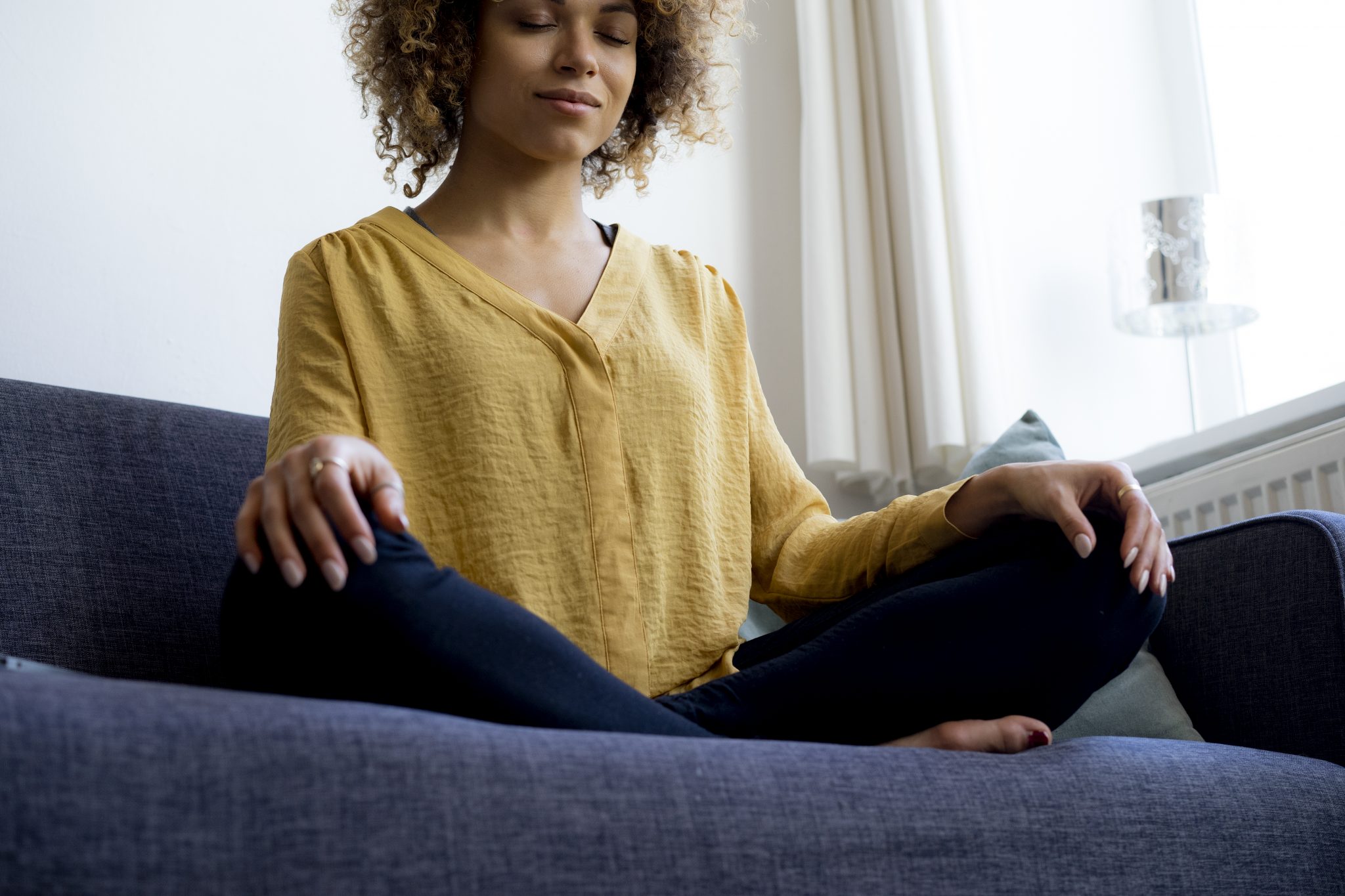5 posture mistakes you’re making and how to fix them
Thanks to our kitchen table desks and bed-based offices, working from home has caused more sore shoulders and aching backs than ever. Here’s how to sort out your posture.
Poor posture is something many of us are guilty of, no matter how hard you’ve tried to create a comfortable working space at home. Firstly, good posture isn’t about sitting ladder-straight – it’s about having a properly aligned spine that allows the body to move fluidly, supporting its own weight in whatever plane of movement it chooses to go through. Poor posture, on the other hand, puts stress on tendons, muscles and ligaments – all of which can lead to chronic neck and back pain.
If you’ve got poor posture and you decide to go for a run, for example, you may find afterwards that your hip, knee or ankle is aching more on one side than the other because your body is slouching to one side. If you’re strength training and can’t retract your shoulders properly, not only is your range of motion going to incredibly limited, but you’re also going to be putting pressure on other parts of your body such as your back.
Ruth Stone is a consultant PT at sweatband.com who says that lockdown has played a role in the decreasing quality of our posture. “We all thought (that lockdown) would be for a short time and many people actually made a point of including their usual – if not more than usual – exercise in their day.But as the situation continued, the weather got worse, the novelty of home working became the norm and the good habits slipped away, people are now moving less and sitting in poor positions for longer.”
You may also like
Posture correctors: are they actually good for your back?
Don’t wait until your body starts sending you warning signs from sore knees, tight backs and stiff necks before you bother correcting it. These are the five most common posture mistakes we make and here’s how you can fix them without going to an osteopath.
Problem 1: sitting cross-legged
We’re not talking about sitting on a yoga mat here, but instead, crossing your legs while at your desk. Ruth warns that it can “cause the pelvis to tilt, the hips to tighten and the spine to misalign, as well as leading to shoulder issues”. There’s also the fact that it’s not a balanced posture – we tend to have the leg crossed over, with our hips skewed the same way for hours at a time.
Solution: Sit with a cushion between your legs to ensure they remain uncrossed every day – the cushion will prevent you from forgetting and slipping back to old habits.

Problem 2: neglecting your core
This mistake is two-fold. If you work at a desk where your keyboard, mouse and screen are in the wrong place, the chances are that you’re either bending over to see what you’re doing, over-stretching to click or hunching over to type. If you prefer to work in bed or on the sofa, you’re doing your posture no favours. Ruth explains, “Sitting propped up in bed with your laptop will do absolutely nothing for your core. You may feel comfy and cosy, but you’re supporting your spine in a collapsed position which, over time, will weaken your core strength.”
Solution: Firstly, get out of bed. Secondly, set yourself up every morning and sit in your best posture directly in front or your computer. Ensure that you can type, look at the screen and manipulate your mouse without collapsing your spine, dropping your chin, twisting your torso or stretching your shoulder. Balance your laptop on a book or position your screen at a different angle if it needs to be.
Problem 3: leaning into your screen
“Often associated with mobile phones, we are now in the Zoom era of leaning and staring at our screens – causing tight neck muscles and stiff shoulders,” Amy says. “We need to stretch the upper back to open up the chest and bring the head back in alignment.”
Solution: Amy recommends the following exercise for a great upper back stretch. Try this exercise below
1.Lie on your front – hands as wide as your mat and in line with your shoulders.
2.Relax your spine and use your muscles to lift your body up into an extension (coming into a kind of ‘Baby Cobra’).
3.Allow for an even curve in your body and keep your shoulders relaxed.
4.Repeat this five times. On the fifth rep, add a neck roll to release your neck muscle.
A common mistake, Amy warns, is pulling the head back without aligning your spine first. To avoid that, lengthen your spine first and then align your head and neck.
You may also like
Posture exercises: 5 upper body stretches to support your back and shoulders
Problem 4: sitting for too long
All this sitting is “making us chair shaped”, according to Amy – meaning that this position is tightening up our hips and lower back. “The muscles will often be tight and weak so we need to stretch and strengthen them.”
Solution: Amy recommends single and double leg kicks which activate the core muscles to enable us to strengthen the lower back and release the hips.
Single leg kick:
1.Lie on your front and prop yourself up onto your elbows. Use the core to stabilise your body.
2.Kick your right foot towards your glutes, while lengthening the core muscles and hip flexors.
3. Do two kicks, switch sides and repeat. Do six reps.
Double leg kick:
1.Lie on your front and place your hands behind your back.
2.Kick both feet to your bottom three times, then reach your feet back to the floor.
3.Extend your upper back up and stretch to open your chest, turning your head to the right.
4.Repeat the kicks towards your bottom, extend your back and turn your head to the left. Do 3-5 reps.
Amy’s final move suggestion for desk-tired bodies is a simple roll up – “perfect for stretching out the lower back and strengthening core muscles”.

Roll-up for lower back and core
1.Lie on your back and reach your arms towards the ceiling.
2.Lift your chest off the floor and use your abs to roll yourself up to a seated position.
3.Reach forward towards your toes to stretch your lower back and hamstrings.
4.Roll your spine evenly back down into the mat. Repeat five times.
Ruth also recommends taking hourly movement breaks, coupled with walking while talking every time you’re on the phone to help your spine release. That screen break also gives your body and mind “a welcome reset”.
You may also like
Physical signs you’re sitting at your desk wrong, and what to do about it
Problem 5: rounded shoulders
Probably the most common posture issue in or out of lockdown is having rounded shoulders, and it’s the kind of thing that you only become aware of in a PT session or gym class when you’re being directly asked to retract your shoulders for a deadlift or goblet squat.
The NHS has a good test to see if you’ve got a rounded shoulder problem. While standing in front of a mirror and letting your arms hang naturally by your side check to see if your knuckles are facing forward. If so, you might have a tight chest and weak upper back – which can cause rounded shoulders.
Another test is to take a breath in and then drop the shoulders to become as relaxed as possible. If you can feel them drop an inch, the chances are that they’ve been hunched around your ears for a while. Can you clasp your hands behind your back? If not, again, shoulder mobility may be restricted.
Solution: You might not necessarily have rounded shoulders just from poor posture, they could also be from too much anterior training and not enough back-based movement. To help, you need to strengthen your upper back, chest and core together and that means doing exercises such as planks, press-ups, bridges, and dumbbell rows.
It’s important to clarify that poor posture isn’t necessarily just a bad habit. We can find ourselves slouching forwards for a number of reasons, including inflexible muscles (ie overly-tight hips) and muscular imbalances. If you’ve got weak core muscles in your back, bum and stomach, you won’t have a strong foundation for keeping balanced. The good news is that you can easily work on improving your posture with these simple exercises.
Follow @StrongWomenUK on Instagram for the latest workouts, delicious recipes and motivation from your favourite fitness experts.
IMAGE: Getty
Source: Read Full Article


